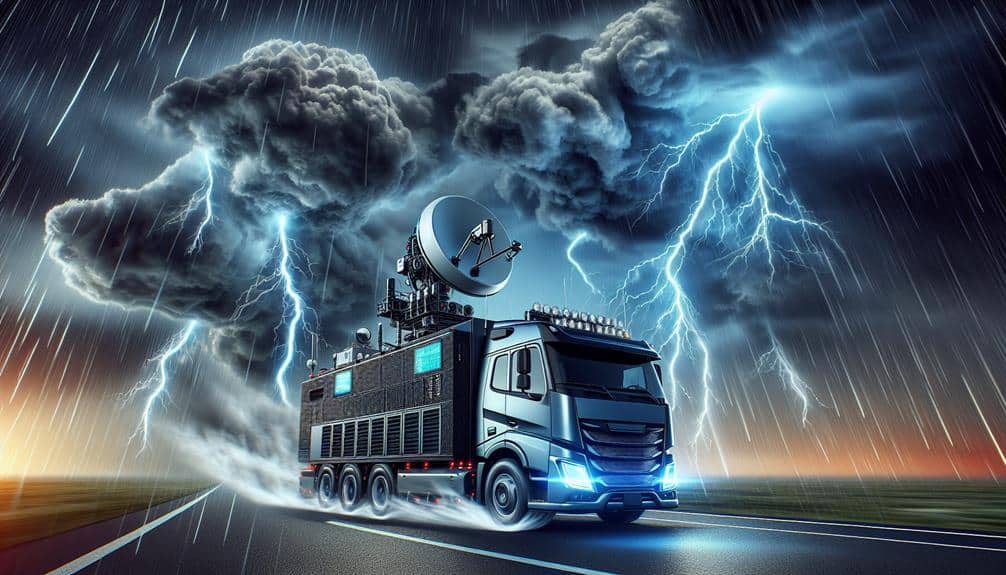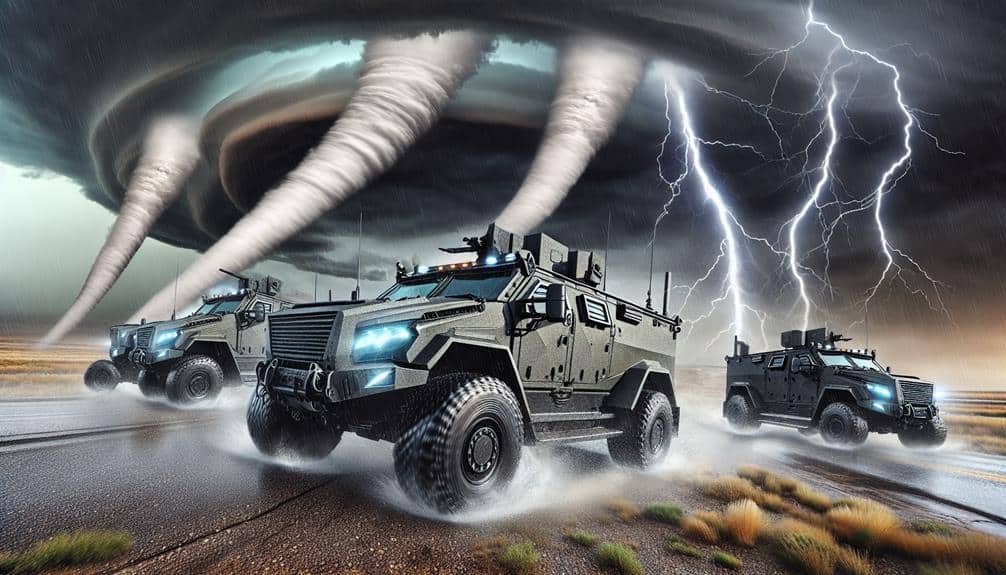When storm chasing, we prioritize dependable weather radios with SAME technology for precise alerts, durable battery life, and waterproof designs. Our GPS devices must be weatherproof, with prolonged battery life and accurate multi-GNSS support for precise navigation. Equally important are tough protective helmets crafted from high-impact materials like polycarbonate, showcasing anti-fog visors and LED lights to improve visibility. We guarantee these helmets provide customizable fittings and adequate ventilation for comfort during prolonged use. With the appropriate gear, we can confront harsh conditions securely and efficiently. Discover more about our particular product recommendations and stay ready.
Key Points
- Reliable weather radios with SAME technology, waterproof design, and long battery life ensure continuous updates and clear audio in severe weather.
- Durable GPS devices with high-sensitivity receivers, multi-GNSS support, and rugged construction provide accurate navigation and withstand harsh conditions.
- Sturdy protective helmets with high-impact resistance, adjustable fittings, padded interiors, and anti-fog visors offer essential head protection and comfort.
- Weather radios with portability and extensive signal range help stay informed about local emergencies and weather changes.
Reliable Weather Radios
For storm chasers, having reliable weather radios is important for receiving real-time updates and staying informed about changing weather conditions. These devices guarantee we maintain effective communication and access to emergency alerts, which are essential for our safety and operational efficiency. Weather radios equipped with NOAA (National Oceanic and Atmospheric Administration) capabilities provide timely broadcasts that are crucial during severe weather events.
In our field, the ability to receive emergency alerts instantly can be the difference between life and death. Radios with Specific Area Message Encoding (SAME) technology allow us to focus on alerts pertinent to our exact location, reducing unnecessary noise and enhancing situational awareness. This technological precision helps us make informed decisions quickly.
We should prioritize features like battery longevity, portability, and signal range in our weather radios. A unit with multiple power sources—batteries, hand crank, solar—ensures we stay connected even in power outages. Clear audio quality and a robust, waterproof design are also necessary, given the unpredictable environments we navigate.
Durable GPS Devices
Dependable GPS devices are necessary for storm chasers to travel safely and accurately during severe weather conditions. When we're out in the field, battling the elements, a sturdy GPS ensures we stay on course and avoid hazardous areas. It's essential to invest in a GPS device that can withstand harsh weather and provide real-time data.
Here are key features to look for in a resilient GPS device:
- Weather Resistance: Our GPS must be waterproof and dustproof to function reliably, even in heavy rain. A waterproof jacket for our gear can be a lifesaver.
- Battery Life: Extended battery life ensures we aren't left stranded. Devices with rechargeable and replaceable batteries offer flexibility.
- Accuracy: High-sensitivity receivers and multi-GNSS support (like GPS, GLONASS) provide precise location data, critical for traveling around storm fronts.
- User Interface: A user-friendly interface with a clear display that's readable in all lighting conditions helps us make quick decisions.
Sturdy Protective Helmets
While reliable GPS devices guide us through treacherous terrains, durable protective helmets shield us from flying debris and potential head injuries during severe storms. When it comes to helmet quality, we can't afford to compromise. High-impact resistance and durability are non-negotiable. The materials should ideally be a composite of polycarbonate and ABS plastic, as these offer excellent protection without being excessively heavy.
Visibility options are equally important. Clear, anti-fog visors or face shields allow us to maintain situational awareness, even in the most chaotic conditions. Some helmets come with integrated LED lights, which enhance visibility during nighttime chases or in dimly lit environments. These features ensure that we don't just stay protected, but also aware of our surroundings.
Adjustability is another essential factor. Helmets with customizable fittings and padded interiors provide comfort for extended wear. Proper ventilation is crucial to prevent overheating, especially when we're in high-stress situations.
Frequently Asked Questions
What Is the Best Type of Vehicle for Storm Chasing?
When considering vehicle selection, we should prioritize off-road capabilities, safety features, and emergency equipment. An SUV with reinforced windows, all-terrain tires, and a robust communication system offers the best balance for storm chasing.
How Do You Stay Safe From Lightning While Storm Chasing?
To stay safe from lightning while storm chasing, we prioritize lightning protection by avoiding open areas and seeking safe shelter options like vehicles or sturdy buildings. We also monitor weather updates for real-time lightning activity.
What Kind of Clothing Is Recommended for Storm Chasing?
For storm chasing, we recommend wearing waterproof jackets and insulated boots. These items guarantee we stay dry and warm, enabling us to focus on the chase without worrying about the elements compromising our safety or comfort.
Are There Specific Apps That Help With Storm Tracking?
For storm tracking, we've found several apps that provide high accuracy. They offer real time updates and alerts, helping us stay informed and safe. Notable mentions include RadarScope, Storm Shield, and MyRadar.
How Can You Prepare for Sudden Changes in Weather Conditions?
Imagine dark clouds rolling in fast. We prepare for sudden weather changes by securing emergency shelters and ensuring our communication devices are charged. Staying informed and ready lets us navigate unpredictable conditions with confidence and freedom.

